What is Maun Vrat (Keeping Silence Vow) information, facts, significance, importance | How to do Maun Vrat
Namaste friends, how are you doing today? Welcome to #BhagavanBhakthi website / blog.
Bhagavan Lord Sri Vishnu (Krishna) (Rama) (Hari) (Narayana) (Trivikrama) (Narasimha) (Vedavyasa) and Goddess Lakshmi (Rukmini) (Sita) (Dharini) blessings to you and your family!
In this website / blog, you will always learn about #Hinduism #Sanskrit language.
Also subscribe to my YouTube channel from this link #BhagavanBhakthi to view videos about #Hinduism #Sanskrit language.
Just before going to “What is Maun Vrat (Keeping Silence Vow) information, facts, significance, importance | How to do Maun Vrat“, let us have some brief information.
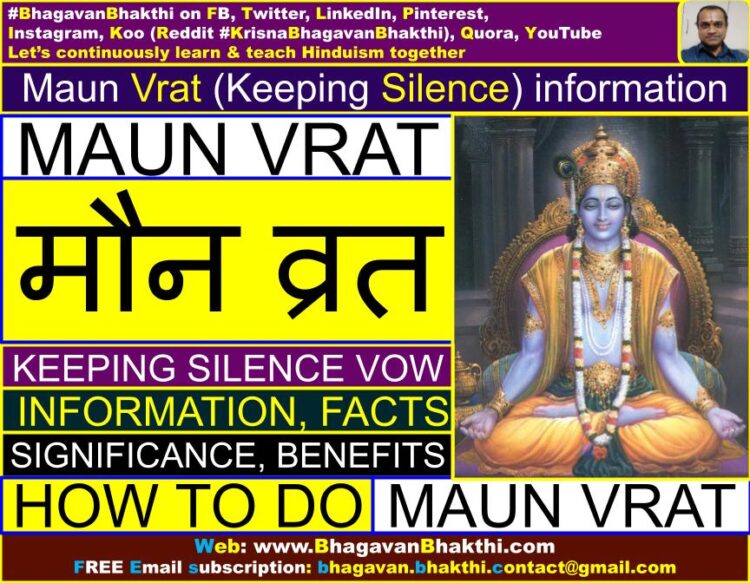
First of all let us know the meaning of the words ‘maun (mauna) (मौन)’ and ‘vrat (vrata) (व्रत)’: Sanskrit maun vrat is written as मौन व्रत (mauna vrata). Both mauna (maun) and vrata (vrat) are Sanskrit words.
mauna (मौन व्रत) – mau + na = mau means talking using mukha / mouth, na = no (not doing). Thus, total meaning of this word is: Someone doing something which is related to ‘not to talk or keeping silence’ for some particular time or day or few days.
vrata – vra + ta – vra = taking vow, ta = doing / taking / performing / practicing.
Vrata or vrat is a Sanskrit word that means “vow, resolve, devotion, something which we do to make Bhagavan Lord Sri Vishnu (And all his avatars) or other Devatas (Demigods) happy”, and refers to pious observances such as doing pooja, fasting and visiting pilgrimage (Tirtha Sthala) places.
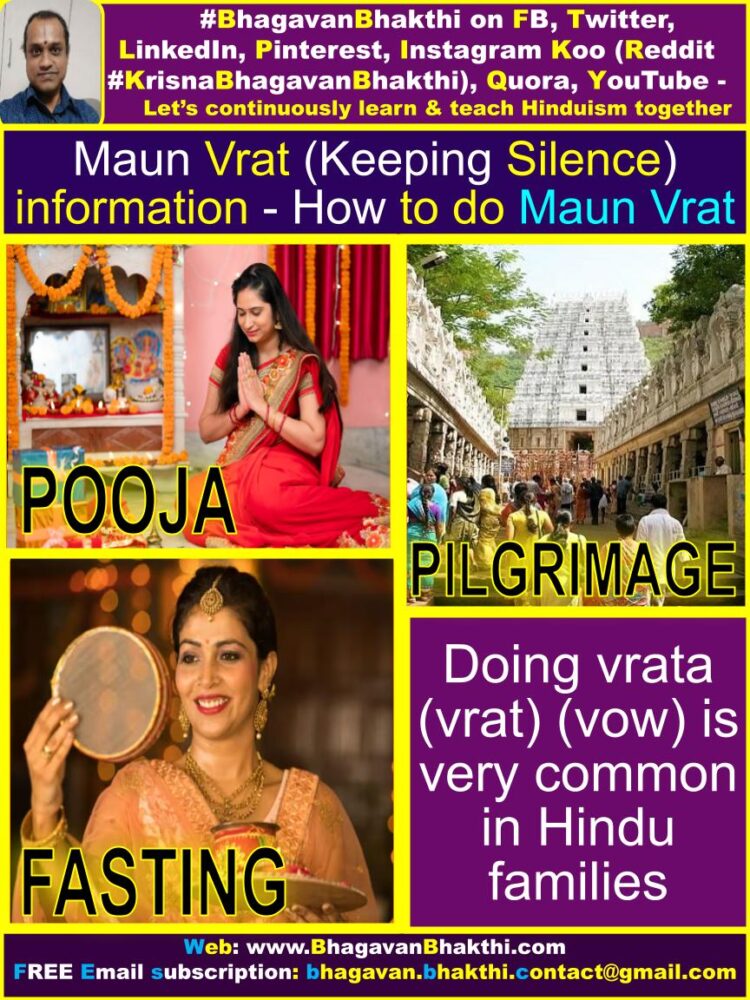
Vrata or Vrat is typically accompanied with prayers (prarthana) for seeking health and happiness for themselves and/or their loved ones as examples for material benefits and for seeking Moksha / Mukti (A permanent place in Vaikuntha) and related for Godly benefits.
Thus ‘mauna vrata or maun vrat’ means taking a vow, so that a person will be doing pious works without talking (keeping silence) for some particular time or for a day or for few days.
Now, let us know the following: What is Mauna Vrata (Maun Vrat)? | What are the significance of Mauna Vrata (Maun Vrat)? | What are Mauna Vrata (Maun Vrat) uses and benefits? |
Mauna Vrata or Maun Vrat means, someone taking a vow to not to talk, to keep silent, to remain mute, meaning not to speak at all for some particular time, or for a day, or for few days. Mauna Vrata or Maun Vrat period could be for a particular period of time ranging for few minutes or hours or a day or few days.
For example, it could be for 48 days, one month or one whole day or from Sunrise to Sunset or for few hours in a day or for new minutes too.
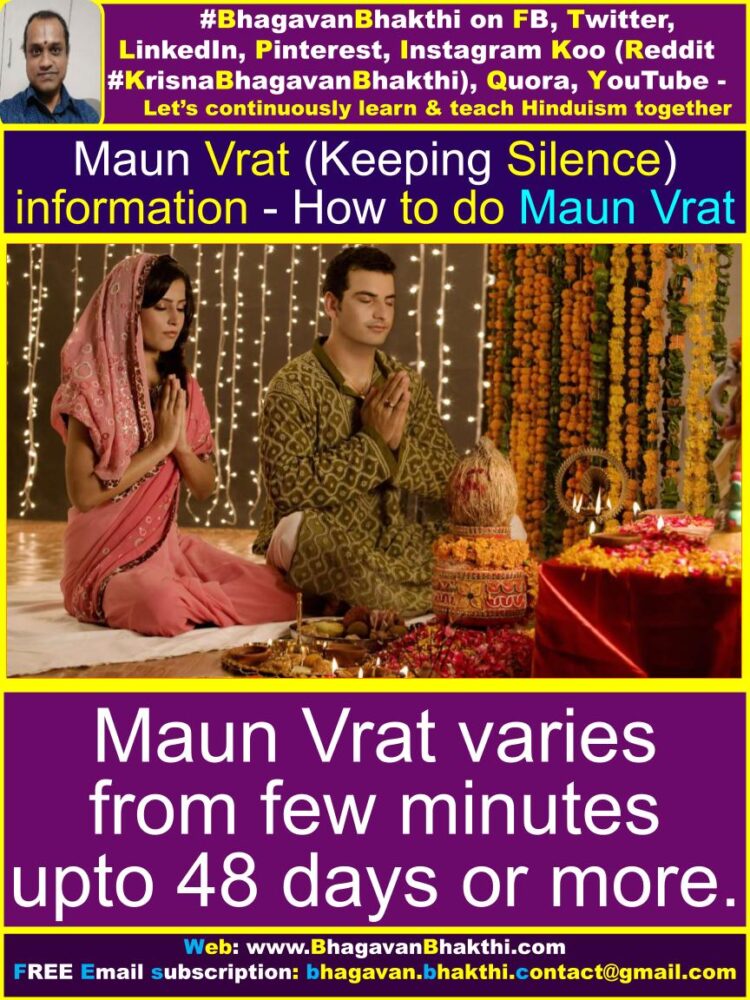
While doing Mauna Vrata (Maun Vrat), he / she should completely avoid watching TV, making gestures, talking over mobiles, exchanging messages over mobile, reading anything which is material etc. But he / she should offer ‘mauna / maun’ / silent prayer to Bhagavan Lord Sri Vishnu, Devatas, Guru.
Bhagavan Lord Sri Krishna in Srimad Bhagavad Gita, shloka #16 of 17th Chapter has said, ‘sraddhatraya-vibhaga-yoga’, that is, Bhagavan Lord Sri Krishna is speaking about ‘mauna / maun’ / silence:
मन: प्रसाद: सौम्यत्वं मौनमात्म-विनिग्रह: | भाव-संशुद्धिरित्येतत्तपो मानसमुच्यते || 17. 16 ||
ಮನಃ ಪ್ರಸಾದಃ ಸೌಮ್ಯತ್ವಂ ಮೌನಮಾತ್ಮ-ವಿನಿಗ್ರಹಃ | ಭಾವ-ಸಂಶುದ್ಧಿರ್ ಇತಿ ಏತತ್ ತಪೋ ಮಾನಸಂ ಉಚ್ಯತೆ || 17.16 ||
manaḥ-prasādaḥ saumyatvaṁ maunam ātma-vinigrahaḥ | bhāva-sanśhuddhir ity etat tapo mānasam uchyate || 17.16 ||
Meaning by word by word : manaḥ-prasādaḥ — satisfaction of the mind | saumyatvam — being without duplicity towards others | maunam — gravity (of keeping silence) | ātma — of the self | vinigrahaḥ — control | bhāva — of one’s nature | saṁśuddhiḥ — purification | iti — thus | etat — this | tapaḥ — austerity | mānasam — of the mind | ucyate — is said to be.
Meaning of the sloka : And contentment, simplicity, gravity (keeping silence), self-control and purification of one’s being are the penances (tapasya) of the mind.
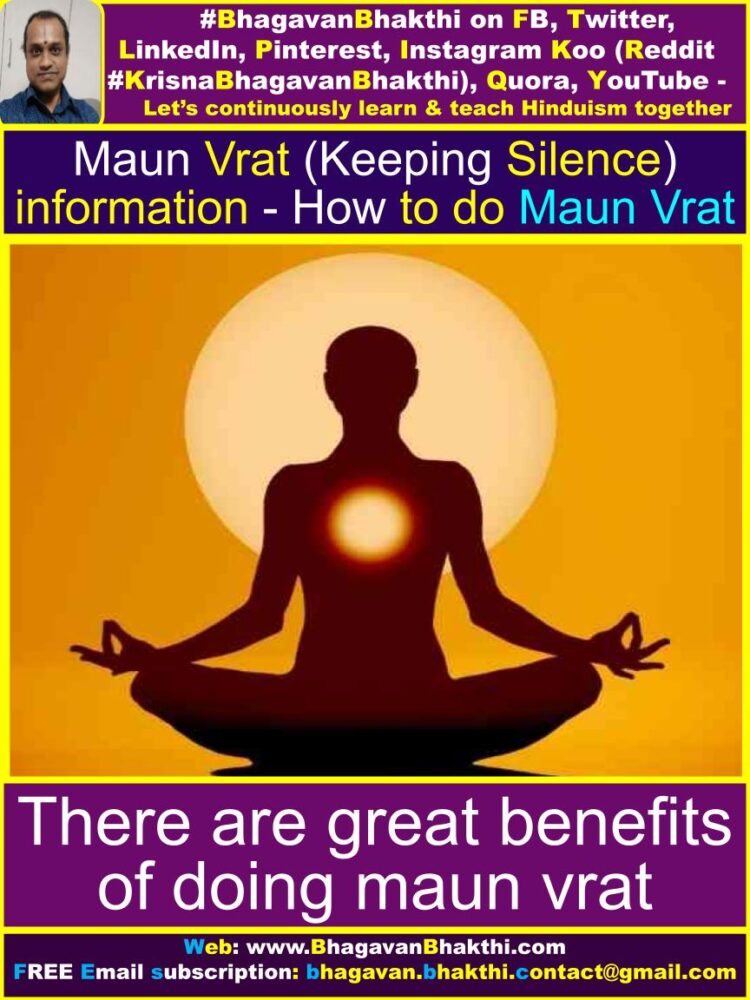
These are the pancha / five values of life and together it is called as Tapas or Tapasya (penance) or ‘mental austerity’. Here ‘maunam’ / silence is present means, ‘manah-prasādaḥ’, that is, peace of mind and ‘saumyatvaṁ’ (gentleness / kind hearted / friendly temperament) can be easily achieved.
Similarly if someone is performing maun vrat (‘maunam’) or someone’s mind is at peace means, will power, self control, restraining oneself can be easily achieved.
Another meaning of the word ‘mauna or maun’ is derived from the word ‘muni’ (monk), that is, an ascetic person who practices ‘maunam’ / silence, the one who will be in the state of constant chintana (contemplation) and remembering Bhagavan Lord Sri Vishnu through the ‘manah shakti’ / mind power.
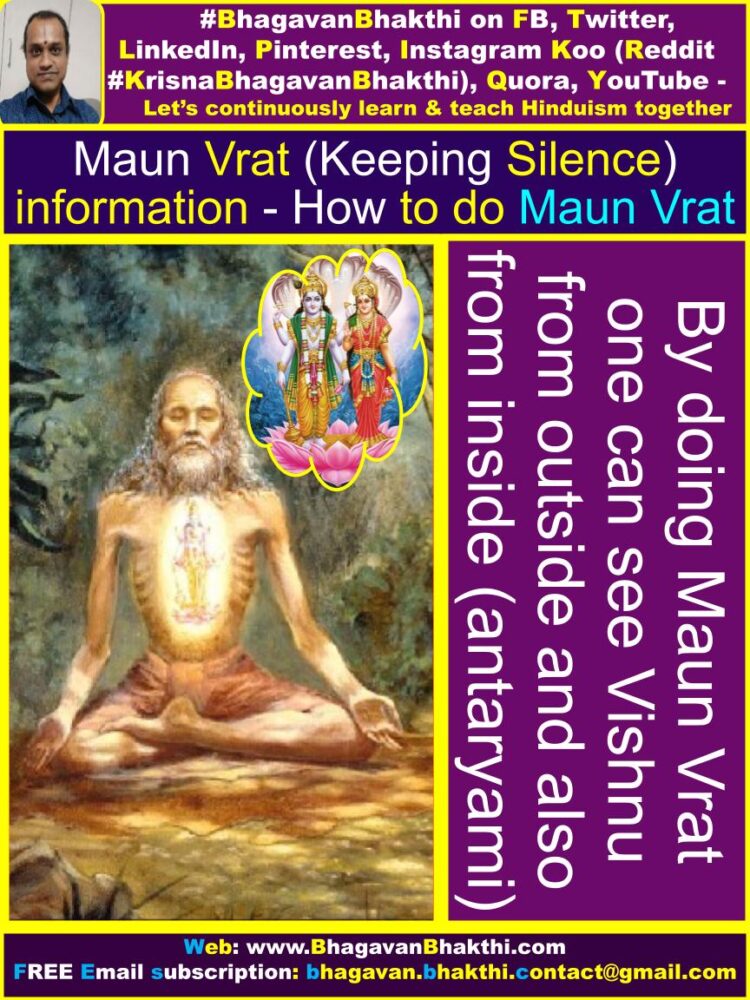
What should we do when in ‘mauna vrata (maun vrat)’: Mauna means total peace, absolute tranquility and not simply shutting ones mouth.
If someone is keeping silent (Maun Vrat), but hundreds and thousands of negative thoughts are coming in his/her mind like lust, money, unwanted food, etc. then what is the use of keeping ‘Mauna Vrata (Mauna Vrata)’. Always think positive and be positive. One should always think of Lord Sri Vishnu and other Devatas (Demigods) and Guru.
Must think about the several unlimited stories (pastimes) of Bhagavan Lord Sri Vishnu in his different avatars like: Lord Sri Varaha | Lord Sri Narasimha | Lord Sri Matsya |Lord Sri Kurma | Lord Sri Vamana | Lord Sri Parashurama | Lord Sri Rama | Lord Sri Krishna | Lord Sri Buddha | Lord Sri Kalki (will take place at the end of this Kali Yuga) etc.
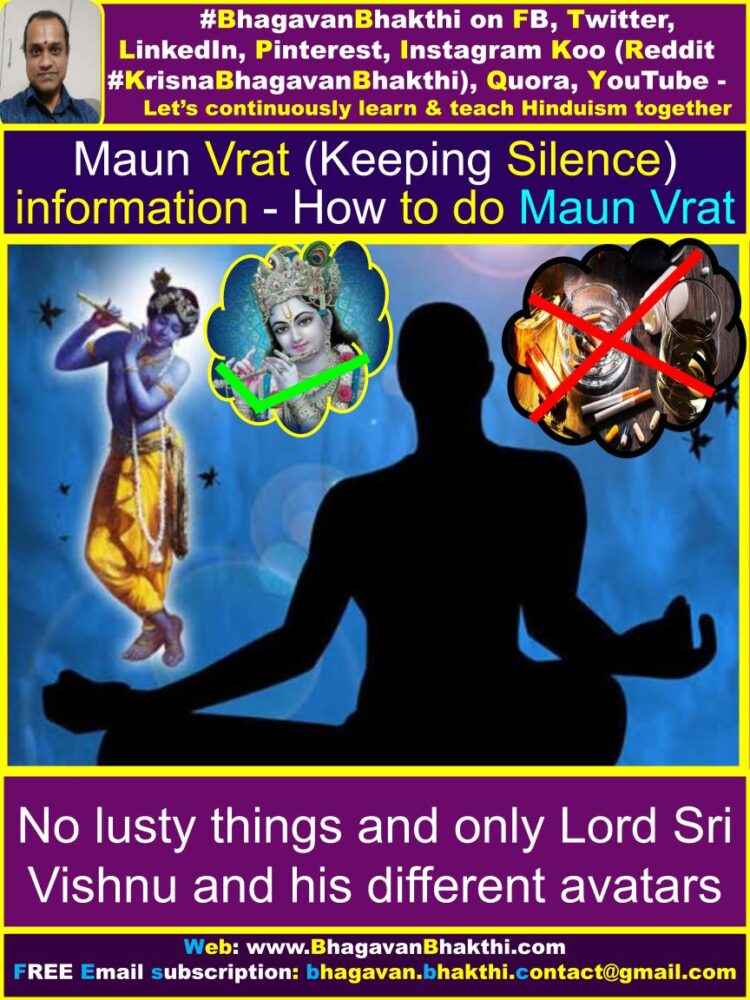
One should chant different names (from the mind) of Bhagavan Lord Sri Vishnu like: श्री कृष्णाय नमः (śrī kr̥ṣṇāya namaḥ) (Sri Krishnaaya Namaha) | श्री रामाय नमः (śrī rāmāya namaḥ) Sri Ramaaya Namaha | श्री गोविन्दाय नमः (śrī gōvindāya namaḥ) Sri Govindaaya Namaha |
श्री अच्युताय नमः (śrī acyutāya namaḥ) (Sri Achyutaaya Namaha) | श्री गोपालाय नमः (śrī gōpālāya namaḥ) (Sri Gopaalaaya Namaha) | श्री मुकुन्दाय नमः (śrī mukundāya namaḥ) (Sri Mukundaaya Namaha) | ॐ नमो नारायणाय (ōṁ namō nārāyaṇāya) (Om Namo Naaraayanaaya) |
ॐ नमो भगवते वासुदेवाय (ōṁ namaḥ śrī vāsudēvāya) (Om Namo Bhagavate Vaasudevaaya) | श्री अनन्ताय नमः (śrī anantāya namaḥ) (Sri Anantaaya Namaha) | श्री विष्णुवे नमः (śrī viṣṇuvē namaḥ) (Sri Vishnuve Namaha) | श्री हरिये नमः (śrī hariyē namaḥ) (Sri Hariye Namaha) |
श्री वासुदेवाय नमः (śrī vāsudēvāya namaḥ) (Sri Vaasudevaaya Namaha) | श्री हृषीकेशाय नमः (śrī hr̥ṣīkēśāya namaḥ) (Sri Hrishikeshaaya Namaha) | श्री आदिदेवाय नमः (śrī ādidēvāya namaḥ) (Sri Aadidevaaya Namaha) etc. etc. etc. |
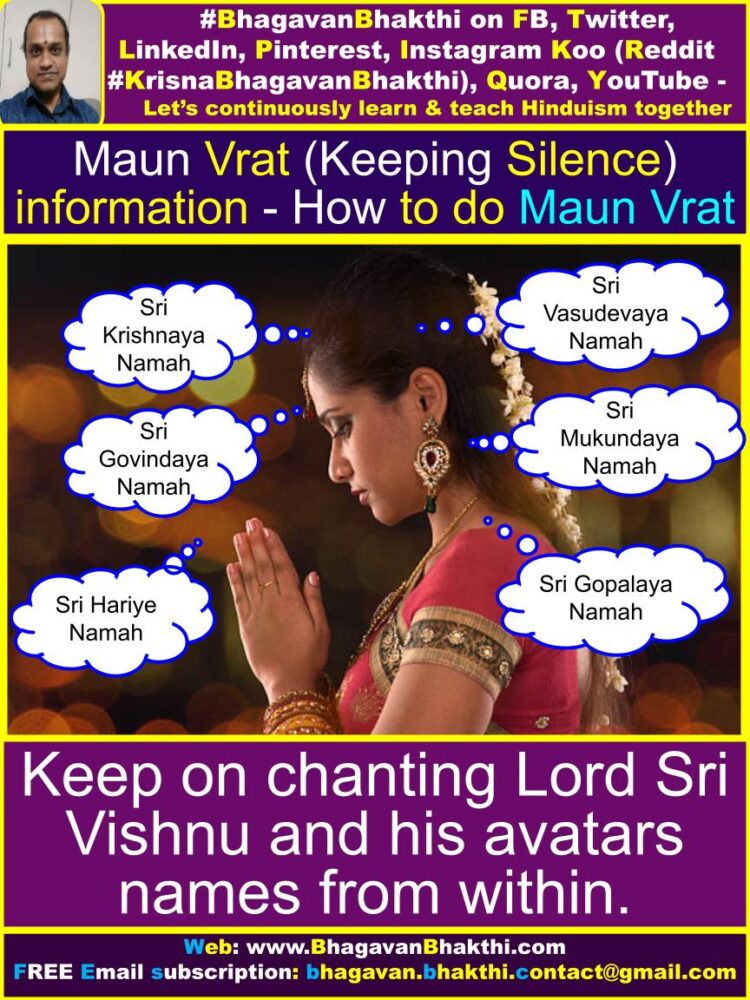
Uses and benefits of doing maun vrat (mauna vrata) are as given below:
1. It helps in obtaining ‘shuddhata’ / purity of speech. | 2. Niyantrana / control of anxiety, negative thinking, anger etc. | 3. Enhances ‘aatma vishvasa’ / self confidence. | 4. Increases self determination. | 5. Increases self control, self discipline. |
6. Change in positive personality. | 7. Increases the opportunity for introspection of self. | 8. Improves meditative ability. | 9. Improves inner peace. | 10. Improves positive energy. | 11. Improves will power. | 12. Increases ‘adyatmikata’ / spirituality. etc. etc. etc.
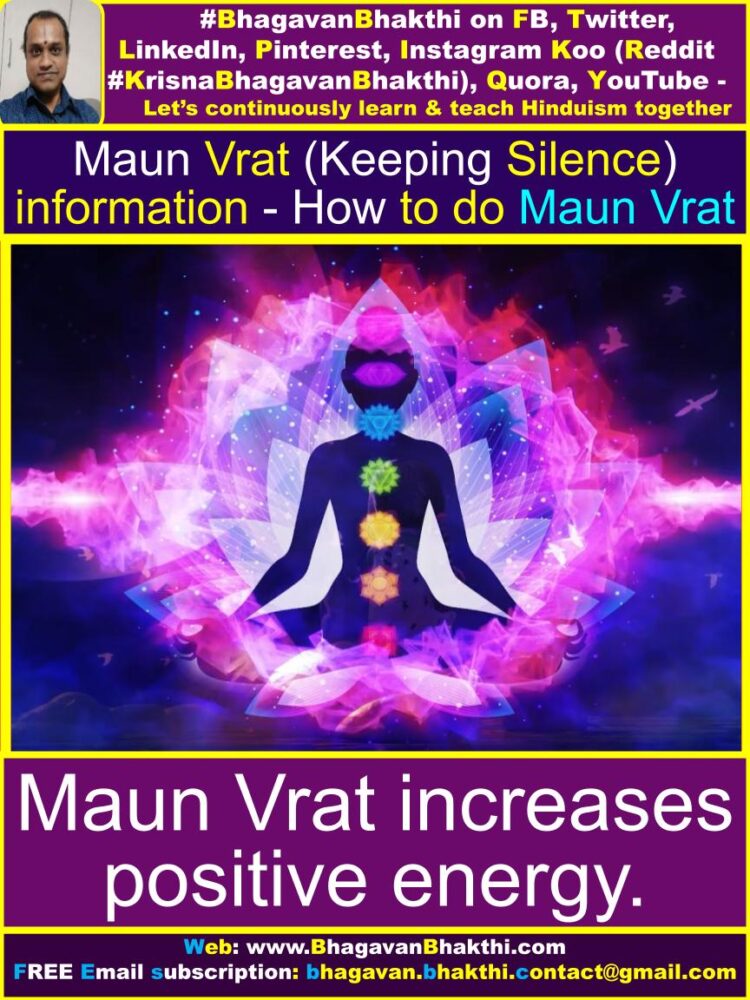
There are unlimited number of benefits of doing ‘maun vrat or mauna vrata’. The above mentioned are very limited.
Few of the great examples of our great people (Hindus) who have done the ‘maun vrat or mauna vrata’ are as given below:
1. Sri Madhvacharya Ji: Sri Madhvacharya Ji spent 48 days in ‘kaashta mauna vrata’ (here kaashta means ‘highly difficult / arduous’) in Badrikashrama (Badrinath), when he got the ‘amantrana’ / invitation from Bhagavan (Sage) Lord Sri Vedavyasa.
Sri Madhvacharya Ji went to ‘uttara badri’ (north Badri) which is still not accessible to Kali Yuga’s humans. The residents of this ‘uttara badri’ were stunned to see the great Sri Madhvacharya Ji. Sri Madhvacharya Ji’s ‘tejas’ / brightness was more than the sun. But, yet it was calm than the moon.
Hence the residents of ‘uttara badri’ decided that it must be somebody who is higher than the Sun and the Moon. Therefore there all decided that he must be Lord Sri Vayu (Mukhya Prana Deva), who has arrived in the form of Sri Madhvacharya Ji.
(Note : Sri Madhvacharya Ji is an avatar of Lord Sri Vayu Deva. Other avatars of Lord Sri Vayu Deva are Sri Hanuman, Sri Bhimasena.)
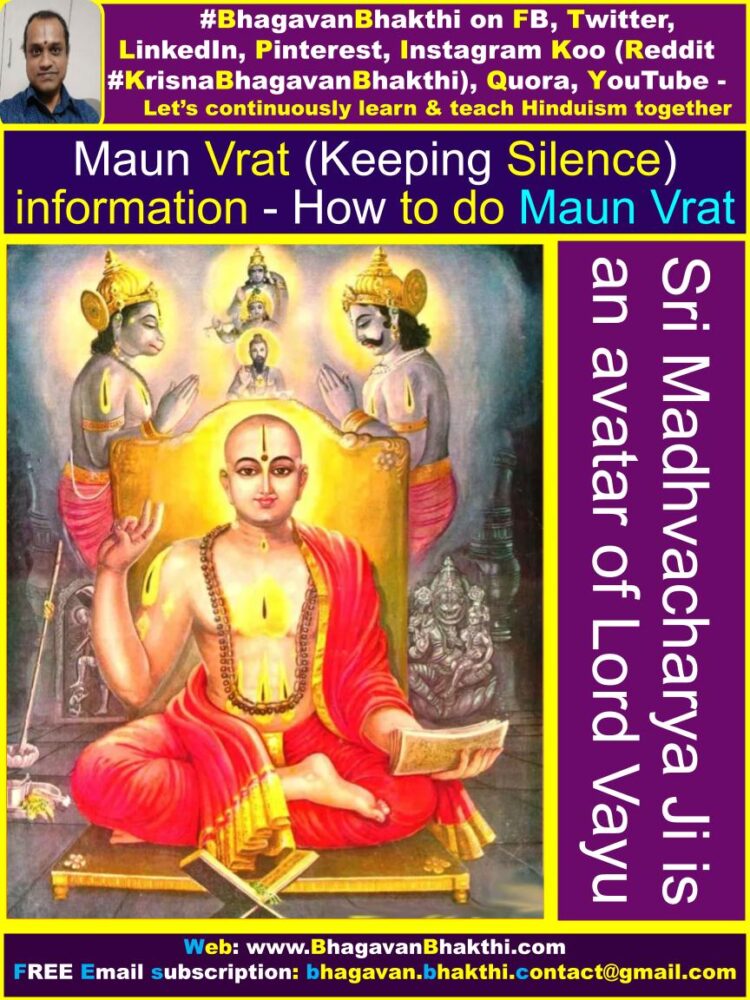
2. Lord Narayana at Badrinath : Even today Lord Narayana (Son of Lord Yama) and avatar of Lord Sri Vishnu is doing maun vrat (mauna vrata) in Badrinath, that is, in the deep Badrikashrama which is not accusable for ordinary humans.
This avatar of Lord Narayana is different and the other form of Lord Narayana which is present is Vaikuntha is different. Both are Lord Sri Vishnu, but avatars are different.
Other than avatar or form everything is same. There is no difference between Lord Sri Vishnu his different avatars. This Narayana is of the Nara-Narayana fame.
3. Nara at Badrinath : Along with the above mentioned Lord Narayana, ‘Nara’, an avatar of Lord Sri Adishesha is also doing tapasya in the deep Badrikashrama. Few Gurus have given commentary that he is an avatar of Lord Indra. But, as per Hindu Texts, he is an avatar of Lord Sri Adishesha Naga as per Sri Madhvacharya Ji.
This is Nara along with Narayana are doing penance since many thousands of years and will continue to do the penance until the end of this Kali Yuga. This is Nara is of the Nara-Narayana fame.
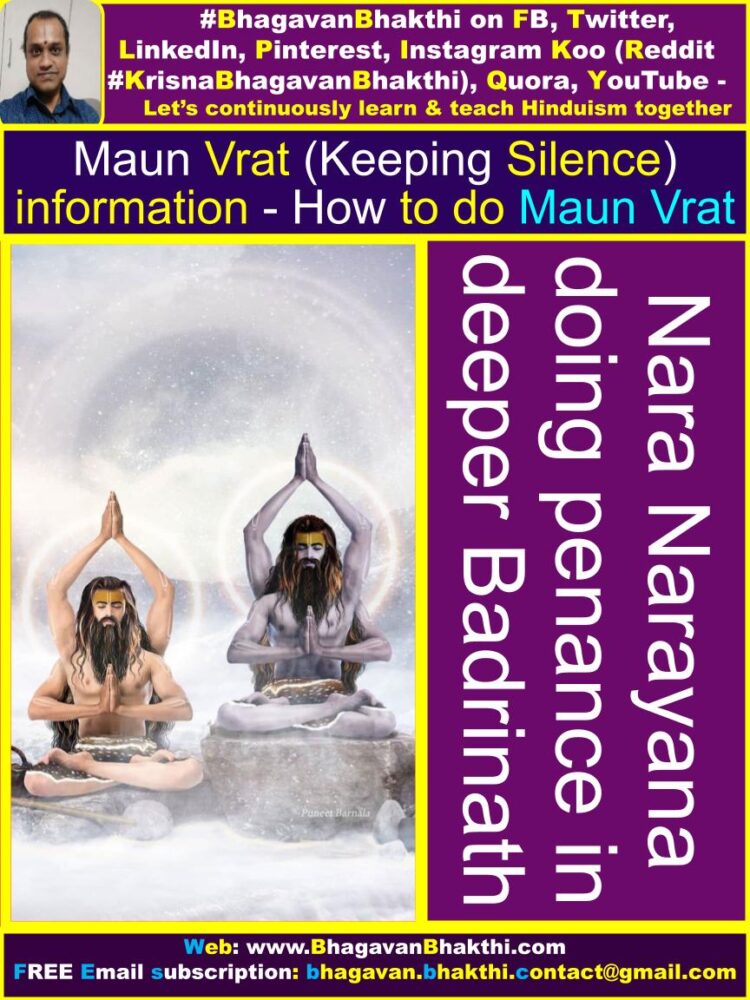
4. Sri Vadiraja Guru : He belongs to Sri Madhvacharya Guru Parampara and he is an avatar of a Ruju. He will be Lord Brahma in the future. He has done ‘kashta mauna vrata’ for 48 days at Badrinath before meeting Lord Sri Vedavyasa and Lord Narayana.
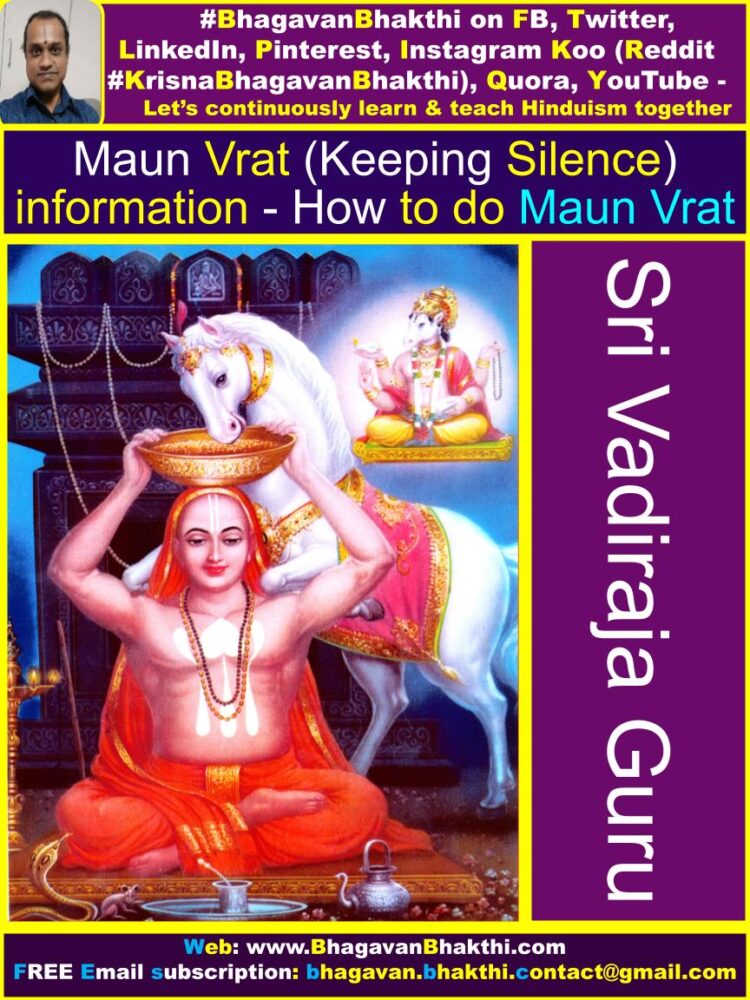
5. Lord Sri Krishna : Lord Sri Krishna used to keep few minutes of maun vrat (mauna vrata) daily in the early morning during the Dvapara Yuga. He was meditative on himself and was thinking of his own pastimes during this time. Concurrently this period no one was disturbing him.
One must always remember that Lord Sri Krishna is not at all dependent on others for anything. He is completely independent and showing the common people how to do ‘Mauna Vrata (Maun Vrat)’. He won’t gain anything by doing any penance or vrat, as he has everything.
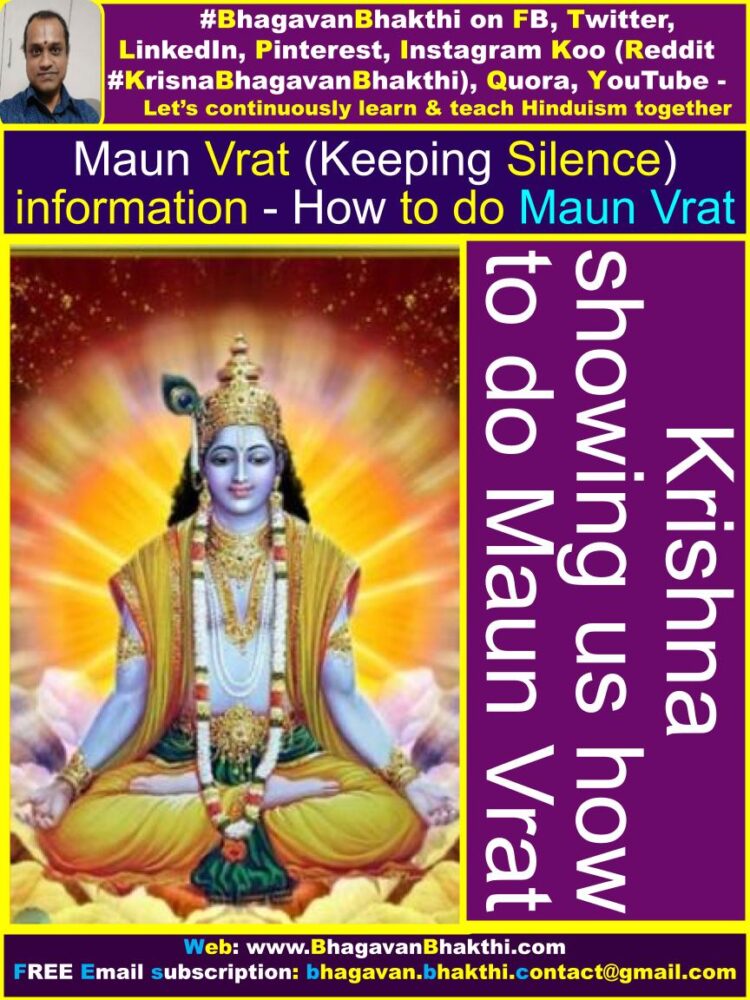
Continue reading about Hindu Samskaras (Sanskars) – Hindu Samskaras (Sanskar) information, significance, importance.
More information will be added to this on regular basis, please visit after some time to know more information.
To watch videos on #Hinduism #Sanskrit language, SUBSCRIBE to my YouTube channel from this below link:
#BhagavanBhakthi YouTube channel
Dear friends, if you need any clarifications about this post, kindly let me know, I will definitely try to answer all of them.
Also your one LIKE, one COMMENT, One Share, one SUBSCRIPTION is highly important.
This will help to know the quality of this content and also it will be helpful to know if any improvements is required for the content.
If you feel this content is useful to you and has helped you to improve your knowledge, kindly share this with your well-wishers.
Because “SHARING MEANS CARING”.
To receive FREE EMAIL SUBSCRIPTION about #BhagavanBhakthi, you can send an email to bhagavan.bhakthi.contact@gmail.com from your email ID.
NAMASTE!
Sri Gurubhyo Namaha
Sri Krishnaaya Namaha
Sri Krishnaarpanamastu
Share in Social Media